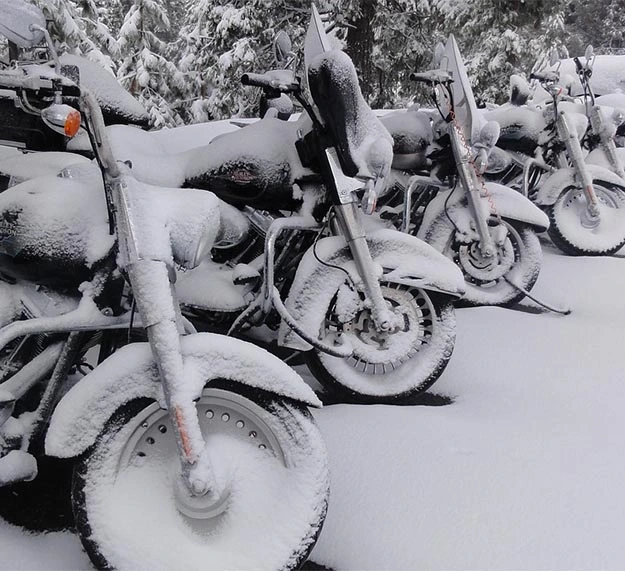Winterising the motorbike and battery
Whether motorbike, scooter, moped or moped: Only the toughest bikers also use their two-wheelers in winter. Especially in low temperatures and dirty weather, long periods of outdoor storage can have a devastating effect on motorbikes and batteries - whether classic lead batteries with liquid acid, gel batteries or modern lithium-ion batteries. As specialists in the storage, transport and disposal of lithium-ion batteries, we have compiled the most important tips for winterising motorbikes and other two-wheelers here:
Disconnect and remove motorbike battery
As cables and connections on motorbikes and scooters are even less protected against environmental influences than on cars, the risk of leakage currents is particularly high here. In addition, many motorbike components continue to consume power even when switched off - and not just the alarm system. If the battery remains connected to the motorbike, there is therefore a risk of deep discharge, which can permanently damage the motorbike battery.
For this reason, the motorbike battery should at least be disconnected or preferably even removed in winter. As a general rule, the contact from the negative terminal should be disconnected first and reconnected last.
It is also advisable to clean the outside of the battery and lubricate the terminals with terminal grease. Among other things, this prevents leakage currents on the surface of the battery and corrosion.
Charging and winterising motorbike batteries
Batteries should be stored frost-free, ideally above 10°C. This is another reason why batteries are better removed in winter.
However, even removed motorbike batteries still have low internal discharge currents. There is therefore a risk of deep discharge during prolonged storage despite the terminals being disconnected. For this reason, the motorbike battery should be charged in winter - either permanently with a so-called trickle charge or every 4 to 6 weeks. When doing so, pay close attention to the instructions for use of the battery or motorbike and charger to ensure that no mistakes are made. Chargers for car batteries, for example, are often unsuitable as they work with excessively high charging currents.
Motorbike batteries may only be connected to a charger if they have been removed or at least disconnected.
After charging, the fluid level of classic ‘wet’ lead-acid batteries must be checked and, if necessary, topped up with distilled water. Maintenance-free gel batteries for motorbikes and lithium-ion batteries as starter batteries, on the other hand, are maintenance-free.
During storage and especially when charging batteries, there is a risk of heat build-up and even spontaneous combustion. This applies in particular to lithium-ion batteries, which can even explode due to thermal runaway. Motorbike batteries should therefore not be stored or charged next to highly flammable materials, even in winter. The storage room should also have a smoke detector. By storing and charging the motorbike battery in a fireproof RETRON BOX, you are playing it safe.
Winterising batteries for electric motorbikes and electric scooters
The above information on winterising refers to classic motorbikes and scooters with combustion engines. However, apart from the recommendations on engine oil, petrol and coolant, they can also be applied to electric motorbikes and electric scooters.
Another difference between combustion engines and electric motorbikes: The lithium-ion batteries of motorbikes and scooters can store much more energy than a starter battery. As a result, they are much more dangerous in the event of a fire and should therefore not be fully charged before winterisation. They are also expensive and should therefore be treated with particular care. The following recommendations therefore apply to electric motorbikes and electric scooters (unless otherwise stated in the operating instructions):
- Protect the lithium-ion batteries from frost. If the batteries are permanently installed, the entire motorbike should be protected from frost. Interchangeable batteries should be removed.
- Due to the high voltages and currents, laypersons should not work on live parts - apart from exchangeable batteries. It is not possible to ‘disconnect’ the battery in the conventional way. For motorbikes with a permanently installed battery, a discharge over the winter must therefore be expected.
- Charge batteries about halfway before winterising and check the charge status every few weeks. Trickle charging is not recommended.
- Both motorbikes with a permanently installed battery and the exchangeable batteries should be stored in a particularly safe place.
In the RETRON BOX, you can store a wide variety of motorbike batteries in a fireproof manner over the winter, as long as they weigh up to 20kg and do not exceed the dimensions 52x42x20cm.
By the way: For larger batteries in the business sector, we offer other fireproof lithium-ion battery containers in which even entire electric car batteries can be disposed of.



